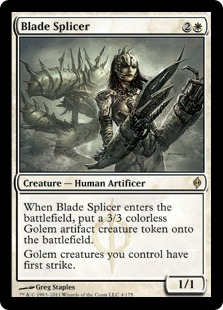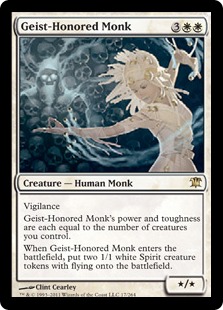Four Colors?
I was super pumped for the Invitational this past weekend—I was going to rock my foil Delvers in Standard and my altered Lightning Bolts in Legacy, and no one was going to get between me and that awesome trophy Max Tietze now owns. I had a flight booked for Thursday afternoon and accommodations set in place for the weekend; nothing could go wrong.
Then I discovered that I was going to a midnight viewing of The Hunger Games that Thursday with my girlfriend.

My reaction
Just kidding, I was happy to move my travel plans to Friday and just play in the Standard and Legacy Opens. We had a blast watching the premiere of The Hunger Games on Thursday night (or early Friday morning), and I can’t say I’m at all unhappy with the way things turned out for me. The change in plans meant that the trip was going to take on a much less serious tone, so I didn’t want to grind out Delver mirrors for ten rounds straight. Since I was going for the sake of having fun, why not play something off-the-wall? I had Heartless Summoning/Unburial Rites and Birthing Pod both sleeved up from recent local tournaments, so I figured I would streamline one of them and take it to the tournament.
I don’t know about you, but if I’m going to play a deck that’s kind of whacky, I’m going to go out of my way to make the lines of play as convoluted as possible while still being viable. While certainly fun to play, the Heartless/Rites deck was rather linear as the goal was to draw cards, discard cards, then cast Unburial Rites and hope it was enough to win the game. The Birthing Pod deck had more interaction (read: blocking) and really lent itself to having more lines of play available. In my research of the deck, I found two main color combinations doing well on Magic Online Daily Events: Bant (G/W/U) and Naya (R/G/W). Unfortunately, I found myself loving aspects of both and couldn’t bring myself to cut a color. (Also, Todd Anderson featured a four-color version of the deck in this video series, and it confirmed for me that the four-color version was viable.)
I loved the idea of Primeval Titan fetching either/both Kessig Wolf Run (better on offense) and Gavony Township (better on defense). I couldn’t let go of my Phantasmal Images because of how powerful it is to be able to sacrifice a Birds of Paradise and turn it into a Titan or Acidic Slime. I recognized the importance of white in the deck to buy time for the Birthing Pod engine to get an overwhelming advantage with defensive elements such as Blade Splicer, Stonehorn Dignitary, Geist-Honored Monk, and the endgame trump Elesh Norn, Grand Cenobite. Finally, cards like Huntmaster of the Fells, Blade Splicer, and Daybreak Ranger are just really good right now in our creature-dominated Standard metagame.
So, Four-Color Birthing Pod it was.
Stabilize, Titan, Elesh Norn
I showed up early to the Standard Open with a list in mind that had everything I wanted in it: Green Sun’s Zenith for Birds of Paradise, Strangleroot Geist, Daybreak Ranger, Huntmaster of the Fells, Acidic Slime, and Primeval Titan; Sun Titan recurring Blade Splicer and Phantasmal Image; Wurmcoil Engine and Geist-Honored Monk to help stabilize until I could start going crazy with my Birthing Pods; and of course Elesh Norn. My sideboard was perfect (read: convoluted and awful), consisting of thirteen different cards including a (really bad) Trinket Mage package for Elixir of Immortality and Hex Parasite. I ran into Todd Anderson before the tournament and asked him for advice, and he convinced me to take out Archon of Justice aka Air Elemental and put in Deceiver Exarch aka Time Walk (life tip: if Todd Anderson tells you something Magic-related, he’s probably right).
Here’s the list I registered:
Creatures (25)
- 1 Solemn Simulacrum
- 4 Birds of Paradise
- 1 Acidic Slime
- 1 Primeval Titan
- 1 Sun Titan
- 1 Wurmcoil Engine
- 1 Viridian Emissary
- 1 Elesh Norn, Grand Cenobite
- 1 Phyrexian Metamorph
- 2 Blade Splicer
- 1 Deceiver Exarch
- 2 Phantasmal Image
- 1 Fiend Hunter
- 1 Geist-Honored Monk
- 1 Daybreak Ranger
- 3 Strangleroot Geist
- 2 Huntmaster of the Fells
Planeswalkers (2)
Lands (24)
Spells (9)

I know what you’re thinking, and the answer is no, the mana base actually isn’t that bad. You have eighteen green sources, with nine ways to fix your mana, and the only color other than green you need two sources for is white, for which you have eight dual lands. The other major concern, "How well does the deck do without Birthing Pod?" was eased by only playing cards that are "good enough" in a vacuum, save perhaps Deceiver Exarch which was great for either buying time by tapping something or gaining time by untapping something.
I’ll admit that the deck can be slow and clunky at times, but if you ever untap with Birthing Pod and a creature in play you can answer almost anything regardless of what your creature is. The deck provides multiple blockers at CMC three, four, five, and six; clones at two and four; lifegain at four and six; removal at three and five; and win conditions at six and seven. I don’t think I lost a single game where I got at least two activations out of the Pod, and my main goal was usually to stay alive long enough for that to happen. I could probably write an entire book about different plays you can make given various board states, but most of my matches could be summarized by the following:
My opponent plays some creatures.
I play some creatures and pass.
My opponent attacks, and I take damage.
I play more creatures and pass.
My opponent uses a removal spell and attacks, and I take more damage.
I play more creatures and pass.
My opponent no longer has good attacks.
I play Birthing Pod and activate it, getting more creatures.
My opponent still doesn’t have good attacks.
Elesh Norn hits the table, all of my opponent’s creatures die, and I swing for lethal.
The absolute most important part about playing this deck is knowing when you’re playing the beatdown role (or, probably more accurately, knowing when you’re not the beatdown). Against any deck that isn’t Frites, Wolf Run, or control you have the inevitability and stalling is generally in your best interest. Sometimes when there are no Birthing Pods in sight, you have to race your opponent, but even in stalemate situations your chance of drawing something to swing the game (any one of three Titans, one Elesh Norn, two Green Sun’s Zenith, two Garruk Relentless, or four Birthing Pod). The deck doesn’t need the help of aggressive creatures like Inferno Titan, Hellrider, or Hero of Bladehold because the deck is already designed to grind out value from a stable board position.
Playing and Critiquing the Deck
I’ll be honest, I probably misplayed more times during the tournament than I would if I played a month’s worth of Mono Red, but that just highlights the raw power of the deck and how difficult it is to play optimally. Throughout the tournament, I was always wondering, "Can I afford to attack?"; "Do I want to get Blade Splicer to block or Fiend Hunter to exile with my Birthing Pod?"; "Do I play Garruk or Solemn Simulacrum in this situation?"; "Is the two life I pay for Birthing Pod worth the tempo in this situation?" Ultimately, I think it all comes down to playing defensively as much as possible and being aggressive as a last resort. I ended up losing in the quarterfinals with two Birthing Pods in my hand because I was too aggressive when I probably could’ve won a longer game. Most of the time I was successful when my first goal was just to clog up the board as much as possible.
Blade Splicer + Golem Token + Geist-Honored Monk + 2 Spirit Tokens isn’t what an aggressive deck wants to see on the other side.
Aside: I think a common misconception about the deck is the threat of a turn 2 Birthing Pod. Against a deck with Mana Leak, sure, you want to resolve your Birthing Pod as soon as possible. However, if you’re facing down creatures from your opponent’s side of the board, it’s much better to play creatures first and only play the Birthing Pod when you have a chance to activate it on the same turn.
By far the most challenging part of the day was sideboarding. I knew what I wanted to bring in, but I rarely knew what I wanted to take out. Primeval Titan was coming out all day against aggressive decks (he does little to stabilize the board), and I often took out Green Sun’s Zenith and Rampant Growth because I figured it was part of the "Wolf Run" package. Other than that, I was really at a loss, pulling out Strangleroot Geist, Daybreak Ranger, and Viridian Emissary most frequently. Was my sideboarding "good?" Probably, as I was always happier to see my sideboard tech than something I took out (save Rampant Growth, pulling those out was probably wrong). But with so many options, I doubt it was "optimal."
Speaking of the sideboard, I was quite happy with it. I know a lot of you probably take one glance at the Trinket Mage package and scoff at it, but I would actually argue in its favor. I won a game versus B/R Zombies where I activated Elixir of Immortality three times after I’d stabilized the board to stay out of burn range. Even though I’d stabilized the board and had my engine going, I was far away from being able to actually attack my opponent and would’ve been in burn range for several turns before I could safely attack. As far as the "real" cards in the sideboard, Oblivion Ring, Celestial Purge and Thrun, the Last Troll were all-stars all day, and I would look to make room for more copies.
As far as cards that underperformed, I would probably start by cutting Viridian Emissary from the main and Thalia, Guardian of Thraben from the side. I just felt like Strangleroot Geist would be better in most situations. Stonehorn Dignitary was hard to evaluate because he was only good enough with Birthing Pod against aggressive decks, so he might be too situational.
Moving Forward…
I expect Birthing Pod to occupy a similar role to Tempered Steel—a viable strategy on raw power level but victim to powerful hate cards. I was excited to see multiple Birthing Pod decks do well over the weekend, and I expect it to remain a viable strategy for its positive matchups against Delver, Zombies, and R/G Aggro. (For those of you looking to add some spice to your Delver lists, I strongly recommend checking out Rudy Briksza Esper Delver list).
I have some special thanks to give out:
-To Alex and Serge for letting me borrow some cards
-To Tom, Jessica, and Ryan for giving me a ride to Baltimore
-To Drew for showing me the potential of Birthing Pod way back in July 2011
And of course,
-To all the writers on SCG and other websites for taking the time to share their knowledge with the community. This is only the third time I have written a MTG-related article for a website, and I’m starting to appreciate just how much people go out of their way in order to bring us their weekly columns.
If you have any questions, you can email me at [email protected].
Thanks for reading!


